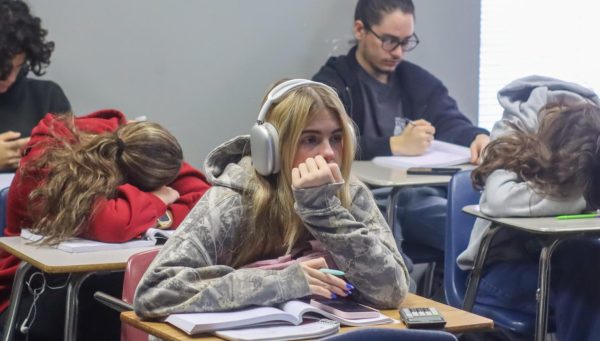Head in the clouds
photo by Alexis Madlang
Many students vape to relieve stress and anxiety, despite its negative health consequences. On-campus vaping has fostered a host of uncomfortable and awkward situations between students, their peers and administrators, who feel that vaping is a real problem.
Walking into the school bathroom, sophomore Mason Kretzschmar was met with a cloud of smoke. Two boys moved back from the sinks as he went to wash his hands, the mirrors foggy from their breath. After he was offered a hit of their vape, Kretzschmar told them no and headed back to class, feeling annoyed and uncomfortable.
“I don’t like it when I’m in the bathrooms and all I smell is vapes,” Kretzschmar said. “I don’t want to deal with that in school.”
According to administrative secretary Patricia Narvaez, vaping on campus has been on the rise. To combat this problem, the administration has increased security, started checking bathrooms more frequently and has even posted signs stating “One person per stall.”
“It’s harmful to the campus environment,” dean Kelly Fate-Quinn said. “We try to talk to students about how harmful it is and educate them on what they’re doing.”
Since its rise in 2007, vaping has become the most commonly used tobacco product among youth in the United States. Vaping is similar to smoking, but instead of cigarettes, vapers use a battery-powered device that vaporizes liquids or solids. These tobacco devices contain the addictive chemical nicotine, and through social media posts and the advertisement of different flavors, teenagers become their ultimate victims.
Similar to Kretzschmar, sophomore Jane* has also been exposed to vaping on campus in the girls’ locker room.
“This girl and I were talking, then she paused and I could see smoke come out in a cloud from behind the lockers,” Jane said. “It was weird, she couldn’t even hold a conversation without using [her vaping device] multiple times.”
As nicotine is a highly addictive chemical, it can become very difficult for students to stop this habit. Symptoms of nicotine withdrawal include headaches, irritability, tremors, trouble concentrating and mood swings.
“I could go without it for a couple of days, but when I would, the thought of it would always be in my mind, making it hard to focus on other tasks. I would need to use my device before or during anything,” sophomore Jennifer* said. “I have relapsed a couple of times. It’s normally when I am in a bad place and someone around me offers, and I feel guilty almost immediately after.”
According to the FDA, 57.8% of student E-cigarette users started vaping because “a friend used it.”
“I started in sixth grade through older friends I met that I believed were ‘cool,’” Jennifer said. “I started because I wanted to fit in and be accepted into the group.”
As students are most commonly exposed to vaping by their peers, it has become a widespread problem on campus. School security guard Darryl Harris said he catches students vaping on campus at least three to four times each week.
“They want to be followers,” Harris said. “They know they will get easily caught for smoking a cigarette on campus, so they use a vape pen instead, which is not any safer.”
As vaping products are not regulated by the FDA, they can easily be laced with harmful chemicals, which many are unaware of. The same FDA study found that 16.6% of students believed that E-cigarettes caused little to no harm to one’s health. This false notion has left many students ill, and some even hospitalized.
“Once, my device was laced with some other chemical that almost sent me to the hospital. I could barely breathe or move, and my heart was racing after using it,” Jennifer said. “Personal sellers could put anything in their devices and you wouldn’t know until you tried it.”
While cases like this may be small in comparison to the large population of users, it is still a serious threat to students’ health and well-being. School resource officer Milton Gil believes that if students were more educated, instances like this would not happen.
“You can’t trust any of it, you don’t know what you are putting in your body,” Gil said. “It is important that high schools gather news and educate students to show them what could happen down the road. They don’t hear the bad things about vaping.”
When trying to quit an addiction, it can be easy to feel defeated and want to give up, but by reaching out to family and real friends, a little help can make a big difference, according to Jennifer.
“I threw all my devices away and told my parents and friends,” Jennifer said. “For me, surrounding myself with people that didn’t use [vaping products] was the most helpful step. Getting off an addiction is hard, but it is possible and you are capable of overcoming it.”
Resources to help quit vaping: 1-800-QUIT-NOW, 1-877-44U-QUIT, Truth Initiative
*names changed by request
Your donation will support the student journalists of Hagerty High School. Your contribution helps us publish six issues of the BluePrint and cover our annual website hosting costs. Thank you so much!










